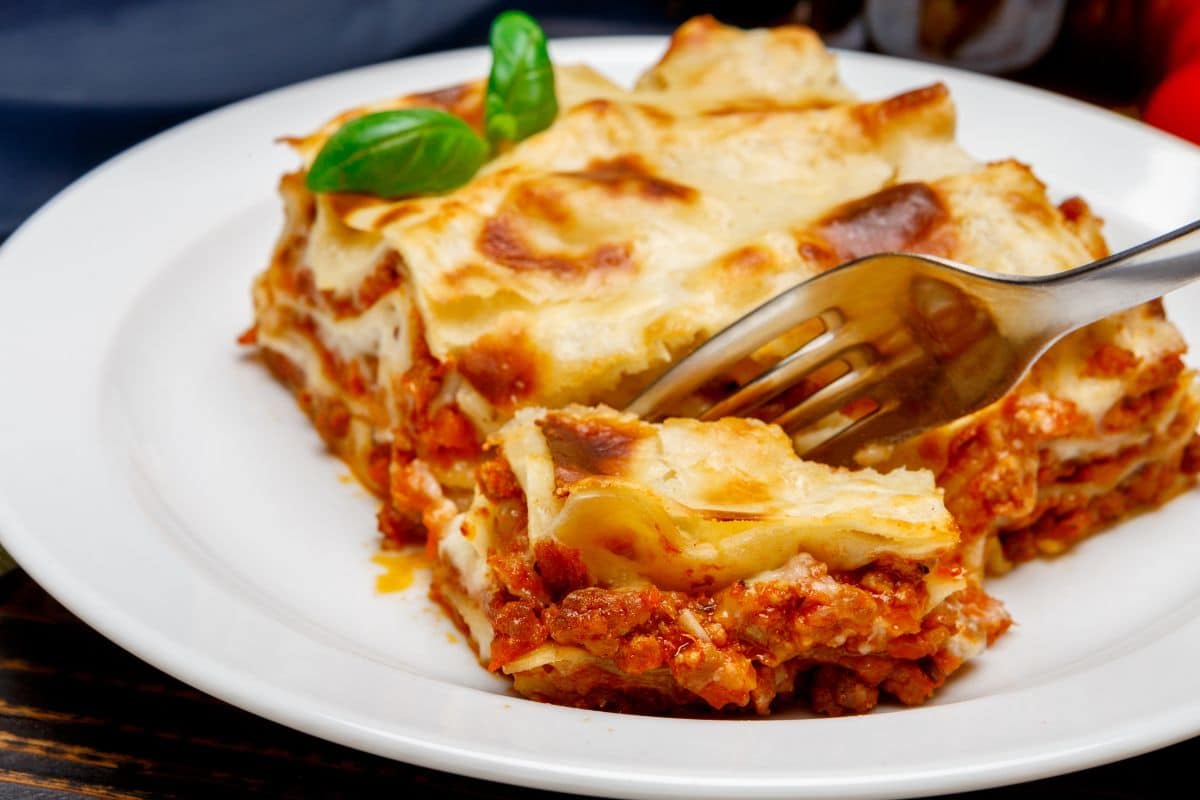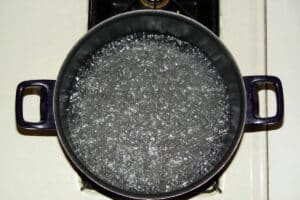Does comfort food get any better than a mouthwatering lasagna? A baked, delicious treat with bubbling cheese, lasagna does take a while to cook but is super simple to make. But you always have the option to buy store-bought lasagna too.

One of the hardest parts about cooking lasagna is knowing when it’s done. After all, who wants to take a bite of cold sauce and noodles? In this article we’ll take a look at how you can tell lasagna is ready, how to reheat it, and some unique lasagna recipes that will have your mouth watering!
What Is Lasagna?
Lasagna is a layered and baked pasta dish that has its roots in 14th century Italy. Classic lasagna has flat and wide noodles, mozzarella cheese, and meat sauce. However, there are many ways you can get creative with lasagna, such as making butternut squash lasagna with Italian sausage and fresh herbs, lasagna with cottage cheese, shredded chicken lasagna, and veggie lasagna.
You can also make lasagna sheets out of potatoes or vegetables rather than standard boiled noodles. To make things quicker, you can ‘oven-ready’ noodles that don’t need to be boiled. However you like to make a lasagna, we recommend you use at least three layers in your dish. You should also use a lasagna pan or deep baking dish so you have plenty of room for the delicious ingredients.
How Long Should You Cook Lasagna?
How much time needed to cook a lasagna properly will be dependent on a couple of things. How many layers your lasagna has, the kind of oven you use (a convection oven or a standard oven), and what ingredients you use. It’s worth remembering that ovens bake at different temperatures.
For example, someone’s 350 °F oven might not be the same as another 350 °F oven. If you know your oven is either on the hot side or the cold side, adjust your receipt accordingly.
Once you’ve made the recipe, then you’ll be able to get the baking time down and achieve the best temperature for your lasagna.
Generally, you should bake lasagna for 45 minutes at 350 °F or 30 minutes at 400 °F. If you’re pushed for time then you can cook your lasagna at a higher temperature.
If your lasagna contains eggs, then you will need to cook it at a lower temperature. We recommend cooking your lasagna for 1 hour at a temperature of 325 °F, then turning the heat up for the rest of the cook to get a nice brown crust on the lasagna.
When Is Lasagna Ready?
There are a couple of signs that your lasagna is ready.
First, you can check the middle of your lasagna with your fork or toothpick. Insert the fork/toothpick into the center of the lasagna, making sure to pierce all the layers, and then pull it back out. If the fork/toothpick has no residue on it, then it’s ready.
Since the ingredients in the lasagna have been cooked already, it just needs to bake until the dish warms all the way through and the cheese has melted. If the top layer of lasagna is a golden brown, that’s also an indicator that it’s done.
Another sign that your lasagna is ready is when the sauce is bubbling around the pan edges. This is a sign that the lasagna has reached its optimal temperature inside.
One of the best ways to check if your lasagna is ready is to use a food thermometer. Insert your thermometer into the middle of the lasagna to take its temperature. The perfect temperature is between 165 °F and 175 °F.
Of course, you can always cut a small piece of lasagna and try it out.
Tips For Cooking Lasagna
Now that we know the signs of a lasagna being done, let’s take a look at some more pointers to help you bake the perfect lasagna at home.
Always place aluminum foil over the lasagna so it evenly bakes. Then, take off the foil for the remaining 10 minutes of the bake so the top layer can brown and melt.
Your lasagna might produce excess liquid while cooking so it’s crucial that you give the lasagna a minimum of 10 minutes to rest before serving.
For the best results, make sure to not use too much sauce. Around ¼ cup each layer in a 9”x13” pan is enough.
If your lasagna remains watery even after it’s rested, then you may need to make tweaks to your recipe.
Common reasons for watery lasagna include incorrect measurements, not letting the lasagna cool before slicing, over-filling, over-layering, not draining excess fat from the meat filling, excessive sauce, veggies that release moisture during cooking, and wet noodles. On this last point, make sure you don’t just put your noodles in the pan straight from the boiling water. Allow them to drain and dry first.
Wet ricotta may also be an issue. You can squeeze out this excess moisture with a kitchen towel, or drain it with a sieve.
Lasagna Leftovers
Once your lasagna is ready and you’ve enjoyed it, there may be some lasagna leftover. Let’s take a look at tips for you to get the most out of your lasagna leftovers.
How To Reheat Lasagna From The Fridge
The best way to reheat lasagna leftovers is in the oven.
First, preheat the oven to 350 °F. Put the lasagna in a baking dish or tray topped with foil and cook for around 30 minutes, or until the sauce is bubbling around the edges and the lasagna is hot all the way through.
You can take off the foil during the last couple of minutes of cooking to make sure the top is brown. Allow it to rest for 10 minutes before serving.
How To Reheat Lasagna From The Freezer
Frozen lasagna takes twice as long to reheat, so you will need to crank the temperature up. Preheat the oven to 375 °F before adding frozen lasagna topped with foil. Bake for around an hour before taking off the foil and letting it cook for an extra 10 minutes. Allow it to rest for 10 minutes before serving.
How Should You Store Leftover Lasagna?
You can store lasagna leftovers in a thin, airtight container, or tightly wrap your lasagna pan in plastic wrap or aluminum foil. You can freeze lasagna leftovers in the same way, just ensure it’s totally cool before you freeze it.
How Long Can Lasagna Sit Out?
Leftover lasagna should rest at room temperature for no more than 2 hours. Once that time has passed, cooked foods are vulnerable to fast and dangerous bacteria growth. This is why you should place your lasagna in the freezer or fridge as soon as possible. Keep in mind that 40 °F and 140 °F is a dangerous temperature range for food.
How Long Does Leftover Lasagna Last?
Lasagna leftovers are best enjoyed the following day. However, you can enjoy refrigerated leftovers for a maximum of 5 days. Meanwhile, leftover frozen lasagna is good for three months.
The Signs That Lasagna Has Gone Bad
It’s a good idea to check for signs of spoilage in leftover food before you eat it. If you notice the following signs, it’s best to dispose of your lasagna.
- Color change
- Excessive moisture
- Mold
- An off taste
- Sour or rancid odor
- Slimy texture
Unique, Delicious Lasagna Recipes
1. Lasagna Cups
Lasagna doesn’t have to be square! Go for a circular lasagna and make these lasagna cups at your next dinner party. All you need is a muffin tin! Lasagna cups are filled to the brim with gooey cheese and a delicious sauce. Not only are they fun to eat, but they taste just like lasagna!
2. Lasagna Soup
Next time you want a comforting bowl of soup, whip up this warming bowl of lasagna soup with elbow pasta. All the lasagna flavors you know and love are in this soup with a dollop of ricotta goodness that melts right into the soup.
3. Polenta Lasagna
Layer polenta in this pasta-free lasagna dish that is incredibly decadent. This polenta lasagna is utterly scrumptious! Once you’ve made the polenta and it’s cooled, the lasagna is quick and simple to throw together.
4. Asparagus Quesadilla Lasagna
You read that right – a quesadilla lasagna! This unique recipe is made by layering whole wheat tortillas and stuffing every layer with spring veggies and slathering with cheese.
5. Summer Lasagna
This carefully layered and stunning summer lasagna can be ready in just 20 minutes, although it’s one of those recipes that looks like you poured hours into it! It takes full advantage of fresh and delicious summer veggies like sweet cherry tomatoes, young fresh basil, and zucchini.
6. Raw, Vegan Gluten-Free Lasagna
This recipe is a great way to enjoy lasagna whether you’re on a raw diet, vegan diet, or gluten-free diet or have any other food restrictions. It blows our mind that the ‘ricotta’ made of pine nuts has no dairy, and how the zucchini ribbons make a worthy substitute for noodles.
7. Spicy Skillet Lasagna
This one-skillet recipe definitely brings the heat and is topped with cottage cheese. But if you’re not a fan of cottage cheese, just swap it out for ricotta. This recipe can also be made in just one pan and is ready in 30 minutes. It tastes just like lasagna without the mess and hassle.
8. Mexican Lasagna
If you want to put a twist on your traditional lasagna, then why not try this Mexican lasagna? With cream cheese, corn, and black beans it’s unique and totally delicious.
9. Lasagna Dip
This appetizer recipe couldn’t be easier to make and is an indulgent dip for dinner parties or game night.
10. Pesto Chicken Lasagna Rolls
Lightly coat lasagna noodles with fresh pesto and roll them into perfect portions for cheesy, chicken-flavored lasagna goodness.
11. Mushroom Lasagna
This veggie lasagna is filled with porcini mushrooms and baked with béchamel sauce. Needless to say, it’s delicious!
12. Veggie Crockpot Lasagna
Another veggie lasagna recipe, this time you bake the lasagna in a crockpot. This lasagna is filled with healthy veggies, some simple ingredients, and couldn’t be easier to make.
13. Cinnamon Toast Crunch Dessert Lasagna
Yes, that’s right – dessert lasagna! For a unique dessert that will blow your mind, just layer your favorite morning cereal.
Final Thoughts
As long as you’ve cooked the lasagna for an appropriate amount of time, the cheese is brown or melting, and if the toothpick or fork comes away clean when you insert it into the lasagna, it’s done!
Frequently Asked Questions
If you overcook lasagna it will come out dry, and the noodles may be brown and crispy.
While homemade lasagna needs to be cooked for 45 minutes at 350 degrees Fahrenheit, you can start checking if the lasagna is ready at the 35 to 45 minute mark, depending on the heat of your oven.
Your lasagna is ready when it has an internal temperature of at least 165 degrees Fahrenheit. You can also check if the lasagna is ready by inserting a fork or toothpick into the middle of your lasagna. If the fork/toothpick is clean, then it’s done.
Another sign that your lasagna is ready is a golden brown top, and bubbling around the pan edges.
You should let the lasagna rest for a minimum of 10 minutes and no more than 20 minutes.
If your lasagna is watery, you should let it rest for a bit longer before you serve it. If it’s still running, drain any excessive liquid from your lasagna pan carefully before re-baking the lasagna for an extra 10 minutes.
Make sure not to place aluminum foil on top of the lasagna. This will keep the moisture inside and prevent your lasagna from thickening.
If you’re able to, take off the top layer of cheese before you put it back in the oven. This will stop the cheese from burning and let excess moisture evaporate.
Cook the lasagna for 7 minutes and put the cheesy layer back on. Sprinkle some additional cheese on top and cook until the cheese browns and melts.
Then, allow the lasagna to rest for a minimum of 10 minutes.
If you don’t have a food thermometer for baking or cooking lasagna, you can use a toothpick instead. Insert a toothpick (or a fork) into the middle of the lasagna. You can also check if a lasagna is ready by trying a small piece of it.







